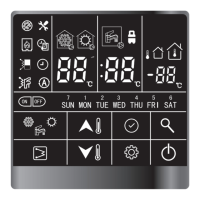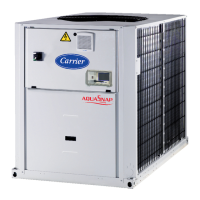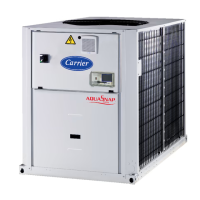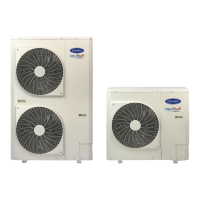27
9 - ELECTRICAL DATA, 30RQS AND 30RQSY UNITS
9.1 - Short-circuit stability current (TN system
(1)
)
30RQS/RQSY 039 045 050 060 070 078 080 090 100 120 140 160
Value with unspecied upstream protection
Short-term current at 1 s - Icw - kA rms
Admissible peak current - Ipk - kA pk
Max. value with upstream protection (circuit breaker)
Conditional short-circuit current Icc - kA rms
Schneider circuit breaker - Compact series
Reference number
(2)
(1) Earthing system type
(2) If another current limitation protection system is used, its time-current and thermal constraint (I²t) trip characteristics must be at least equivalent to those of the
recommended Schneider circuit breaker.
The short-circuit stability current values above are suitable with the TN system.
9.2 - Electrical data, hydraulic module
The pumps that are factory-installed in these units comply with the European Ecodesign directive ErP. The additional electrical
data required
(1)
is as follows:
Motors of single and dual low-pressure pumps (OPTIONS 116T, 116U)
No.
(2)
Description
(3)
30RQS/RQSY
039 045 050 060 070 078 080 090 100 120 140 160
1 Nominal efciency at full load and nominal voltage % 81,1 81,1 81,1 81,1 81,1 81,1 81,1 81,1 83,4 83,4 84,8 84,8
1 Nominal efciency at 75% rated load and nominal voltage % 80,8 80,8 80,8 80,8 80,8 80,8 80,8 80,8 81,2 81,2 82,2 82,2
1 Nominal efciency at 50% rated load and nominal voltage % 77,5 77,5 77,5 77,5 77,5 77,5 77,5 77,5 78,3 78,3 79 79
2 Efciency level IE3
3 Year of manufacture
This information varies depending on the manufacturer and model at the
time of incorporation. Please refer to the motor name plates.
4
Manufacturer's name and trademark, commercial
registration number and place of manufacturer
5 Product's model number
6 Number of motor poles 2 2 2 2 2 2 2 2 2 2 2 2
7-1
Rated shaft power output at full load and nominal voltage
(400 V)
kW 0,8 0,8 0,8 0,8 0,8 0,8 0,8 0,8 1,3 1,3 1,7 1,7
7-2 Maximum power input (400 V)
(4)
kW 1,1 1,1 1,1 1,1 1,1 1,1 1,1 1,1 1,6 1,6 2,4 2,4
8 Rated input frequency Hz 50 50 50 50 50 50 50 50 50 50 50 50
9-1 Rated voltage V 3 x 400
9-2 Maximum current drawn (400 V)† A 2,1 2,1 2,1 2,1 2,1 2,1 2,1 2,1 2,9 2,9 4,2 4,2
10 Rated speed rpm 2850 2850 2850 2850 2850 2850 2850 2850 2890 2890 2870 2870
r/s 47 47 47 47 47 47 47 47 48 48 48 48
11 Product disassembly, recycling or disposal at end of life
Disassembly using standard tools. Disposal and recycling using an
appropriate company.
12 Operating conditions for which the motor is specically designed
I - Altitudes above sea level m < 1000††
II - Ambient air temperature °C < 55
IV - Maximum air temperature °C
Please refer to the operating conditions given in this manual or in the
specic conditions in the Carrier selection programs.
V - Potentially explosive atmospheres Non-ATEX environment
(1) Required by regulation 640/2009 with regard to the application of directive 2009/125/EC on the eco-design requirements for electric motors
(2) Item number imposed by regulation 640/2009, annex I2b.
(3) Description given by regulation 640/2009, annex I2b.
(4) To obtain the maximum power input for a unit with hydraulic module add the maximum unit power input from the electrical data table to the pump power input.
† To obtain the maximum unit operating current draw for a unit with hydraulic module add the maximum unit current draw from the electrical data table to the pump current
draw.
†† Above 1000 m, a degradation of 3% for each 500 m should be taken into consideration.

